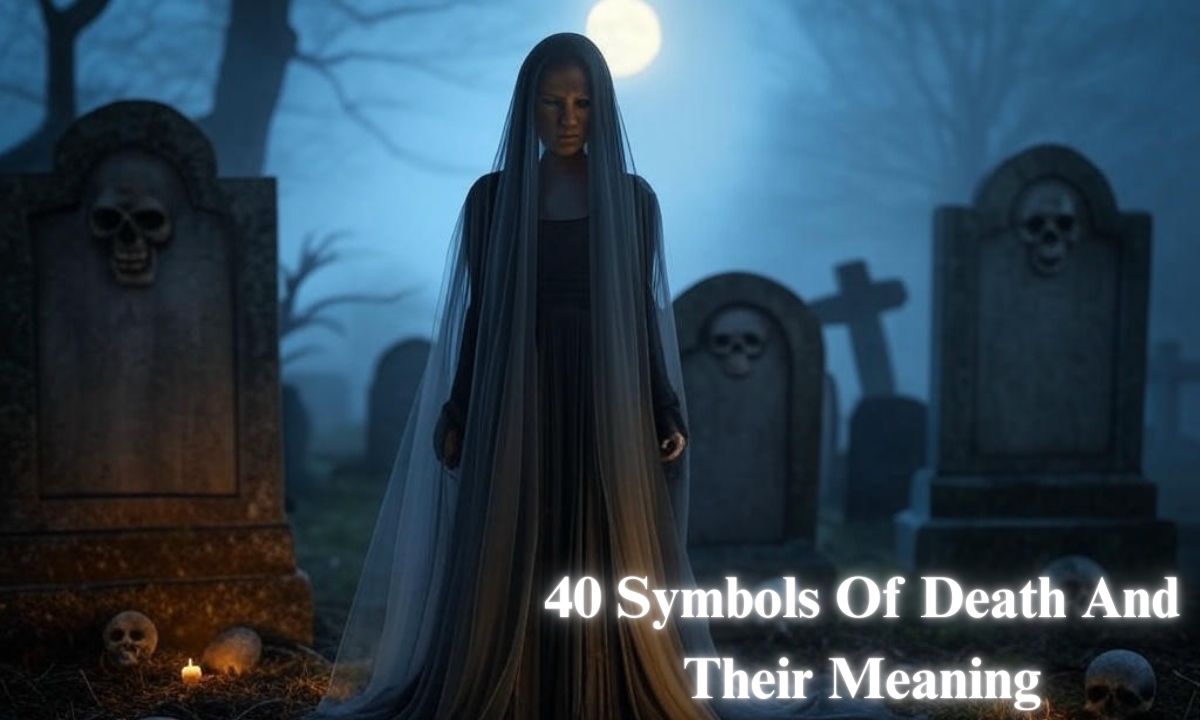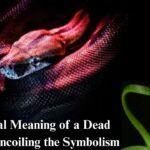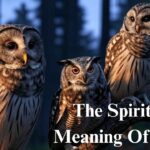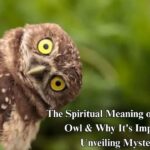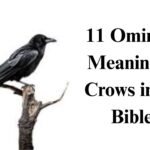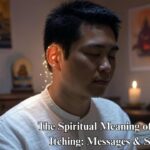Death is universal. Every culture confronts mortality. Symbols help us understand this inevitable transition. These powerful representations span across time and place. They show how humanity perceives the end of life. Some evoke fear while others bring comfort. All reveal our complex relationship with death.
Throughout human history, we’ve created visual metaphors to express our feelings about mortality. From ancient Egypt to modern times, these symbols help us process grief and contemplate our finite existence. They remind us that death is not just an ending but often a transformation.
These 40 symbols of death reveal the diverse ways we interpret life’s final chapter. Each symbol carries its own story and significance. Together, they paint a rich picture of how we understand mortality and the afterlife.
1. The Grim Reaper
The Grim Reaper stands as death personified. A hooded figure carries a sharp scythe. His skeletal appearance inspires fear. This iconic messenger comes for all eventually. The dark robe symbolizes the unknown nature of death. His scythe represents the cutting of life’s thread.
Western culture embraced this image during medieval times. The Reaper serves as a reminder of mortality. He does not discriminate between rich or poor. This figure appears in countless artistic works. The Grim Reaper represents death’s inevitability and impartiality.
2. The Skull
The human skull remains perhaps the most recognizable symbol of death. Empty eye sockets stare back at observers. The permanent grin reminds us of our fate. Skulls appear across all cultures as mortality representations. They strip away our individual differences.
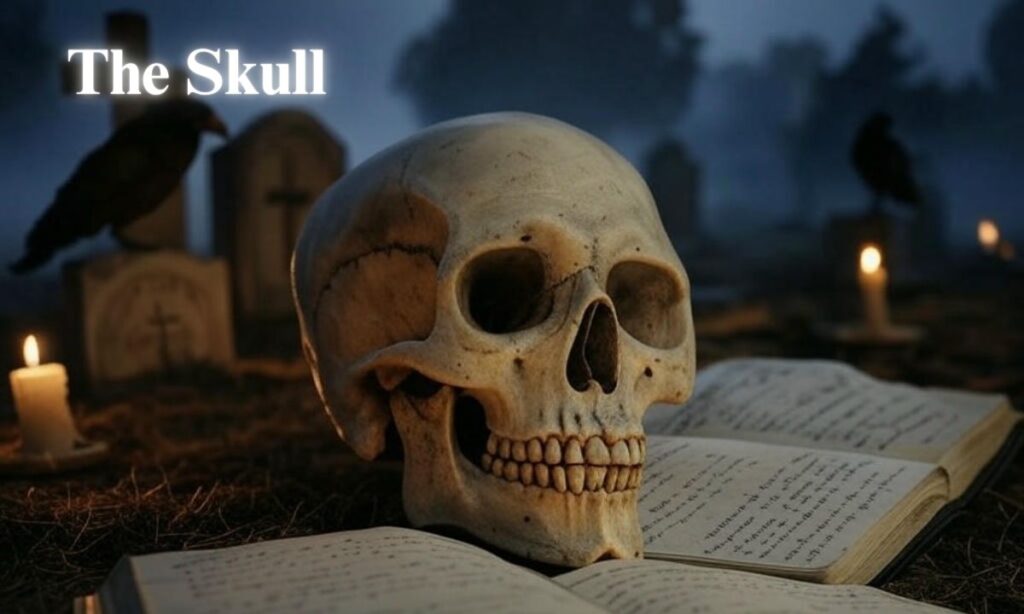
Mexican culture celebrates skulls during Day of the Dead. Pirate flags featured them as warnings. Medieval art used skulls in “memento mori” paintings. The skull’s universal recognition transcends language barriers. It represents what remains after life departs.
3. The Hour Glass
The hourglass measures our finite time on earth. Sand falls grain by grain without pause. This ancient timekeeper symbolizes life’s limited duration. When the top chamber empties, our time ends. The hourglass appears in countless paintings about mortality.
Medieval scholars kept hourglasses on their desks. They served as constant reminders of life’s brevity. The hourglass reminds us to use our time wisely. Its symmetrical shape suggests balance between life and death. This symbol encourages meaningful living before our sand runs out.
4. The Coffin
The coffin represents our final resting place. This wooden box contains our earthly remains. Its rectangular shape accommodates the human form. Coffins feature prominently in funeral rituals worldwide. They mark the boundary between life and death.
Ancient Egyptians created elaborate coffins for pharaohs. Victorian coffins often featured decorative elements. Modern coffins range from simple to extravagant. This container symbolizes the physical reality of death. The coffin’s closed lid represents final separation from the living world.
READ THIS BLOG : Exploring the Spiritual Meaning of Sleeping with Hands Above Head
5. The Tombstone
The tombstone marks where bodies rest. Stone tablets preserve names and dates. They stand as lasting memorials to lives ended. Cemeteries worldwide display these solemn markers. Tombstones represent our desire for remembrance after death.
Ancient grave markers were simple stone piles. Medieval tombstones featured religious imagery. Modern gravestones often include personal touches. These markers serve as remembrance symbols for loved ones. They transform burial grounds into places of memory and reflection.
6. The Vulture
The vulture circles patiently above dying creatures. These scavengers feed on recently deceased animals. Their presence signals death has occurred. Many cultures view vultures with mixed feelings. These birds serve an essential ecological function.
Ancient Egyptians associated vultures with protective goddesses. Some Native American tribes saw them as cleansers. Western tradition often portrays them as omens. Their bald heads and dark feathers create a distinctive silhouette. Vultures represent nature’s recycling of life and death.
7. Skeleton
The human skeleton reveals what lies beneath our skin. Bones remain long after flesh decays. This framework supports us throughout life. Skeletons dance in Day of the Dead celebrations. They remind us of our common structure beneath surface differences.
Medieval art featured dancing skeletons leading people away. Halloween decorations commonly use skeleton imagery. Medical students study bones to understand human anatomy. The skeleton represents what remains after life departs. This enduring structure symbolizes our mortality and fragility.
8. Dead Tree
The dead tree stands bare against the sky. Its branches reach like bony fingers. No leaves emerge in spring’s warm embrace. Yet even in death, it provides habitat for creatures. The dead tree symbolizes life’s natural conclusion.
Artists often include barren trees in desolate landscapes. Literature uses them to represent grief or loss. Yet dead trees eventually return nutrients to soil. This natural cycle demonstrates death and rebirth in nature. The dead tree teaches that endings nurture new beginnings.
9. The Black Cat
The black cat prowls through superstitions worldwide. Its dark fur blends with shadows and night. Medieval Europeans associated them with witchcraft. Their glowing eyes seemed supernatural in darkness. Many cultures connect these felines with death and misfortune.
Japanese folklore sees them as bringers of good fortune. Celtic mythology linked black cats to fairy realms. Western traditions warn against black cats crossing paths. Their silent movement and nocturnal habits fed these associations. Black cats represent mystery and the thin boundary between worlds.
10. The Mourning Dove
The mourning dove sings a distinctive melancholy call. Its soft cooing sounds like expressions of grief. These gentle birds appear in many funeral traditions. Their name directly references sorrow and loss. Their presence brings comfort to many mourners.
Native American tribes associated them with peaceful transitions. Christian traditions sometimes link them to the Holy Spirit. Their gentle nature contrasts with harsher death symbols. Mourning doves represent the tender side of grief. Their songs remind us that expression of sorrow is natural.
11. The Owl
The owl watches silently from darkness. Its ability to see at night seems magical. Many cultures connect owls with death and wisdom. Their distinctive calls sound eerily human. Owls appear as both helpers and harbingers.
Ancient Greeks associated owls with Athena, goddess of wisdom. Some Native American tribes saw them as death messengers. Medieval Europeans feared their night presence. Their ability to rotate their heads seems unnatural. Owls represent the mysterious wisdom that death contains.
12. The Bat
The bat emerges only after sunset. These flying mammals navigate through darkness. Their cave dwellings resemble entrances to underworlds. Folk tales connect them with vampires and blood. Their unusual appearance contributes to death associations.
Mayan culture viewed bats as guardians of the underworld. Chinese traditions see them as symbols of good fortune. Western Gothic imagery embraces their mysterious nature. Their upside-down resting position seems unnatural. Bats represent the spiritual death meanings found in darkness.
13. Ouroboros
The Ouroboros shows a serpent eating its own tail. This ancient symbol appears across many cultures. It represents eternal cycles of destruction and creation. Nothing truly ends but transforms instead. This circular image challenges linear views of life and death.
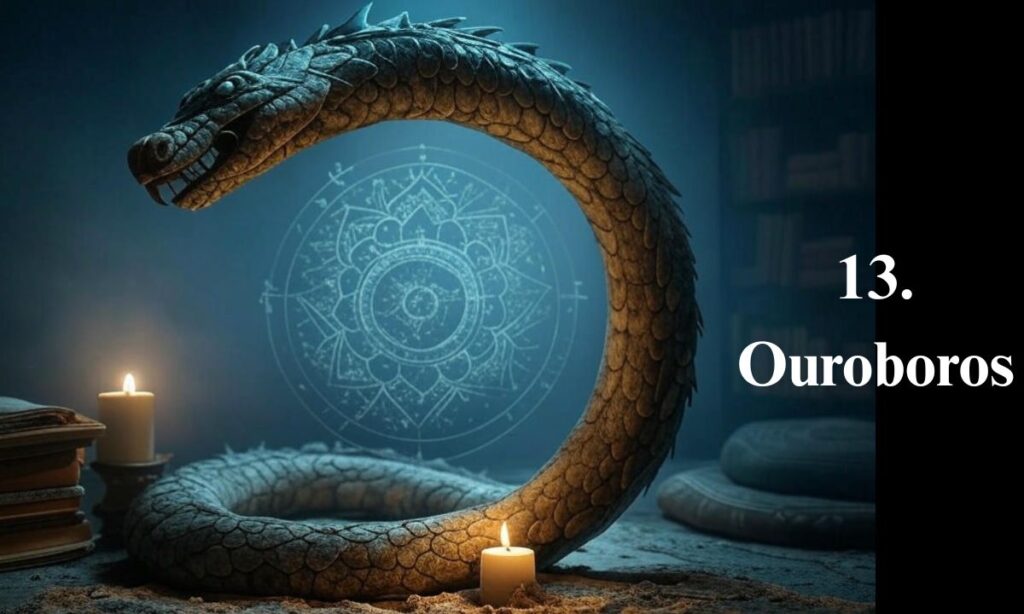
Ancient Egyptians carved it on tomb walls. Alchemists used it in mystical texts. Carl Jung identified it as an archetype of human consciousness. The snake consuming itself demonstrates perpetual renewal. Ouroboros reveals the intimate connection between endings and beginnings.
14. The Noose
The noose represents a violent end. This simple rope forms a deadly loop. Historical executions used this method frequently. Its image evokes both justice and tragedy. The noose symbolizes punishment and despair.
Western films feature it in frontier justice scenes. Literature uses it to represent hopelessness. Its simplicity contrasts with its lethal purpose. The noose stands as a dark reminder of mortality. This symbol cautions against desperation and judgment.
15. The Cross
The cross transcends its role as a religious symbol. Early Christians faced crucifixion as punishment. Christ’s death transformed this torture device. Now it represents sacrifice and redemption. The cross connects suffering with spiritual transformation.
Christian art centralizes the crucifix image. Cemetery headstones often feature cross designs. This vertical and horizontal intersection symbolizes meeting points. The cross represents divine death and transformation. It reminds believers that death leads to resurrection.
16. Extinguished Candle
The extinguished candle once provided light. Its flame offered warmth and visibility. When snuffed out, darkness immediately returns. This simple image powerfully represents life’s end. Many funeral traditions incorporate candle symbolism.
Victorian mourning rituals included candle extinguishing. Some cultures light candles annually for deceased relatives. The transition from light to darkness happens instantly. This sudden change mirrors how death can come swiftly. The extinguished candle reminds us of life’s fragility.
17. The Mirror
The mirror reflects our changing image throughout life. Covered mirrors feature in Jewish mourning traditions. Some cultures believe mirrors capture souls at death. Their reflective surface shows truth without a filter. Mirrors represent self-knowledge and mortality.
Victorian mourning customs included covering household mirrors. Some traditions warn against letting the deceased see themselves. Ancient civilizations made mirrors from polished obsidian. Their ability to show aging connects them with time’s passage. Mirrors reveal uncomfortable truths about our mortality.
18. The Snake
The snake sheds its skin and emerges renewed. Biblical tradition casts it as a tempter toward death. Its venom brings swift end to many creatures. Yet medical symbols incorporate healing serpent imagery. Snakes embody both death and transformation.
Hindu traditions associate Shiva with cobras. Ancient Greek healing temples kept sacred snakes. Aboriginal stories feature rainbow serpent creation myths. Their ability to rejuvenate through shedding symbolizes rebirth. Snakes remind us that death often leads to renewal.
19. Rotting Flesh
Rotting flesh confronts us with decay’s reality. Decomposition begins immediately after death. This natural process recycles our physical form. Many religious traditions address this uncomfortable truth. Rotting flesh represents our inevitable return to earth.
Medieval art depicted decaying corpses as warnings. Modern forensic science studies decomposition stages. Some Buddhist practices involve meditating on corpses. This direct confrontation with mortality removes denial. Rotting flesh teaches acceptance of natural cycles.
20. Blood
Blood symbolizes both life and death simultaneously. This vital fluid sustains our existence. When spilled, it signals injury or death. Red blood dramatically contrasts with pale skin. Many religious and cultural traditions incorporate blood symbolism.
Ancient sacrifice rituals centered around blood offerings. Battlefield imagery inevitably includes bloodshed. Medical contexts view blood as essential for diagnosis. Its color and viscosity make strong visual impressions. Blood represents the thin boundary between living and dying.
21. The Black Butterfly
The black butterfly flutters between worlds. Its transformation from caterpillar seems magical. Many cultures see butterflies as departed souls. Their brief lifespan mirrors human fragility. Black ones specifically connect with death symbolism.
Mexican folklore associates black butterflies with returning ancestors. Irish traditions saw them as souls unable to reach heaven. Philippine culture sees them as visiting deceased relatives. Their silent, erratic flight path seems otherworldly. Black butterflies represent spiritual transformation after death.
22. The Waning Moon
The waning moon gradually disappears night by night. Its decreasing light symbolizes life’s decline. Ancient calendars tracked this predictable cycle. Many cultures connect moon phases with life stages. The waning moon represents approaching endings.
Pagan traditions associate it with the crone goddess. Agricultural societies planned harvests by moon phases. Its predictable return as the new moon promised rebirth. This celestial cycle demonstrates death and rebirth visually. The waning moon teaches that darkness precedes new beginnings.
23. The Funeral
The funeral gathers the community around loss. These ceremonies honor deceased individuals. Every culture develops specific funeral traditions. These rituals help living process grief. Funerals represent structured responses to death’s chaos.
Ancient Egyptian funerals prepared souls for afterlife journeys. Viking funerals sent warriors to sea in burning ships. Modern services balance celebration of life with mourning. These gatherings acknowledge collective loss and support. Funerals transform private grief into shared experience.
24. The Plague Doctor
The plague doctor wore a distinctive beaked mask. Medieval physicians filled these beaks with herbs. Their protective clothing created an eerie silhouette. These doctors faced overwhelming death daily. Their image represents human response to mass mortality.
Historical plague outbreaks killed millions across Europe. These doctors had limited medical knowledge or tools. The distinctive mask has become a cultural icon. Their presence signaled community crisis and fear. Plague doctors remind us of death’s historical impact on society.
25. Phoenix
The phoenix burns completely to ashes. From these ashes, it rises renewed. This mythical bird appears across many cultures. Its fiery rebirth defies death’s finality. The phoenix represents triumph over mortality itself.
Ancient Egyptian traditions featured the bennu bird. Chinese mythology celebrated the fenghuang. Arabian tales spread the phoenix legend westward. This creature symbolizes hope after complete destruction. The phoenix teaches that transformation requires complete surrender.
26. Crows & Ravens
Crows and ravens appear as death messengers. Their black feathers absorb all light. Intelligent behavior makes them seem almost human. Their harsh calls sound like warnings. These birds feature in countless death myths worldwide.
Norse mythology gave Odin’s two ravens as scouts. Celtic traditions saw them as battlefield prophets. Native American stories cast them as tricksters and creators. Their scavenging nature connects them with death scenes. Crows and ravens represent wisdom gathered from mortality.
27. Scythe
The scythe harvests crops with sweeping efficiency. This farming tool became Death’s signature implement. Its curved blade cuts through many stalks at once. The Grim Reaper wields it to “harvest” souls. The scythe represents death’s indiscriminate nature.
Medieval farmers used scythes for crucial harvests. The tool’s design remained unchanged for centuries. Its practical purpose transformed into symbolic meaning. This blade servers the connection between body and soul. The scythe reminds us that death harvests all eventually.trf’”
28. The Color Black
The color black absorbs all light completely. Western traditions use it for mourning attire. Its absence of color represents the absence of life. Black clothing signals grief across many cultures. This color symbolizes the unknowable nature of death.
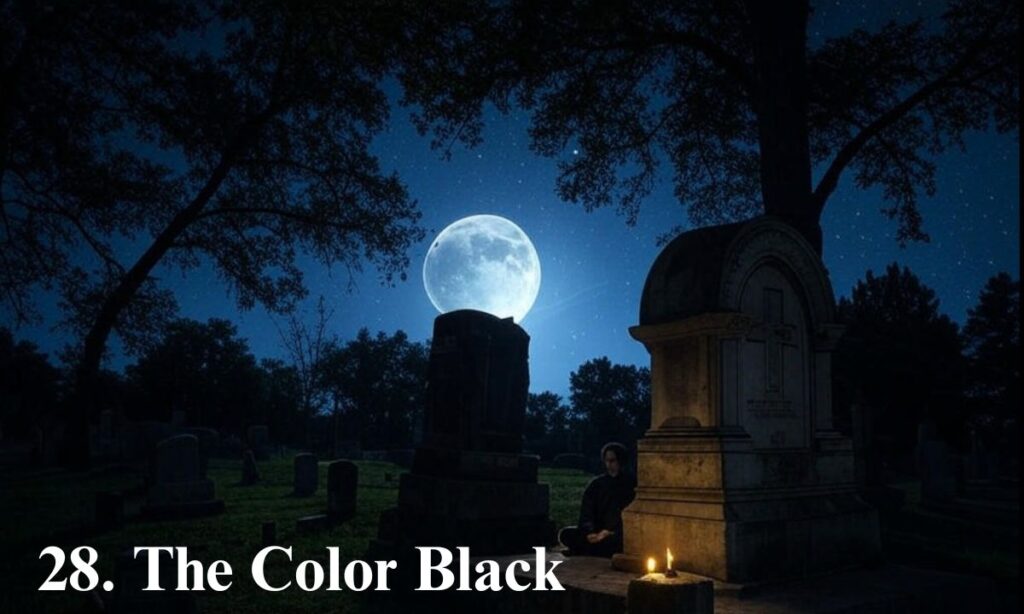
Victorian mourning traditions prescribed black clothing periods. Funeral hearses traditionally appear in black. The night sky’s darkness creates primal fears. Black represents both mystery and finality. This color acknowledges the shadows death casts on those remaining.
29. Poppy
The red poppy blooms brilliantly but briefly. These flowers grew on World War I battlefields. Their blood-red petals commemorated fallen soldiers. Now they represent remembrance for military sacrifices. Poppies symbolize both beauty and sacrifice.
Veterans Day celebrations feature poppy displays. Their delicate petals last only days when picked. The contrast between soft flowers and harsh warfare is striking. Poppies serve as remembrance symbols worldwide. These flowers transform battlefield death into honored memory.
30. Stairway to Heaven
The stairway to heaven connects earth with the afterlife. This vertical pathway appears in many religious traditions. Souls climb toward divine judgment or reward. This architectural metaphor makes abstract transition concrete. The stairway represents a structured journey after death.
Ancient Egyptian tombs included stairway imagery. Jacob’s biblical ladder showed angels ascending and descending. Renaissance art depicted souls climbing toward salvation. This symbol offers comfort through orderly progression. The stairway suggests death as a journey rather than an endpoint.
31. Anubis
Anubis guided souls through Egyptian afterlife. This jackal-headed god judged the deceased. He weighed hearts against truth’s feather. His animal aspects connected him with death and decay. Anubis represents protective guidance through death’s territory.
Ancient Egyptians praised him in tomb inscriptions. His image adorned coffins and burial chambers. Priests wore Anubis masks during mummification rituals. This deity transformed fearsome death into a managed process. Anubis demonstrates how death mythology provides comfort.
32. Cerberus
Cerberus guarded the entrance to the Greek underworld. This three-headed dog prevented living from entering. It also kept dead souls from escaping. Its multiple heads maintained constant vigilance. Cerberus represents boundaries between life and death.
Greek hero Hercules captured Cerberus as his final labor. Orpheus lulled the beast to sleep with music. Roman poet Virgil included him in the Aeneid. This creature enforced natural order between worlds. Cerberus reminds us that death maintains necessary boundaries.
33. Death’s Head Moth
The death’s head moth bears skull-like markings. Its unique pattern appears on its thorax. When threatened, it emits a squeaking sound. European folklore considered it an omen. This moth represents nature’s incorporation of death imagery.
These moths feed on honey from beehives. Their scientific name is Acherontia atropos. Literature and film feature them in gothic contexts. Their unusual appearance occurs naturally. Death’s head moths show how death symbolism exists throughout nature.
34. Yama
Yama judges souls in Hindu and Buddhist traditions. This deity determines appropriate rebirths. He carries a noose to catch departing spirits. His buffalo mount represents power and steadfastness. Yama embodies death’s impartial judgment.
Ancient Vedic texts describe his heavenly court. Buddhist mandalas depict him holding the wheel of life. His skin appears blue-black in artistic representations. This deity maintains cosmic order through judgment. Yama demonstrates how death creates accountability.
35. The Wheel of Fate
The wheel of fate turns without human control. This circular symbol represents life’s unpredictability. Fortune rises and falls as the wheel turns. Death comes when our position reaches the bottom. The wheel represents cycles beyond our influence.
Medieval illustrations showed humans clinging to turning wheels. Fortune personified controlled its movement. Tarot decks include it as a major arcana card. This symbol teaches acceptance of natural progression. The wheel reminds us that change remains constant.
36. Death Tarot Card
The Death tarot card shows a skeleton on horseback. It rarely predicts literal death in readings. Instead, it represents transformation and change. This card appears frightening but brings renewal. Its imagery confronts our fear directly.
Traditional Rider-Waite decks show death carrying a black flag. The skeleton represents what endures through change. This card ranks thirteenth in the major arcana. Its appearance signals necessary endings in life. The Death card teaches that renewal requires releasing what’s complete.
37. Death Masks
Death masks preserved facial features after death. These plaster or wax impressions captured final expressions. Famous historical figures received this treatment. Families kept these as remembrance objects. Death masks represent attempts to preserve identity beyond death.
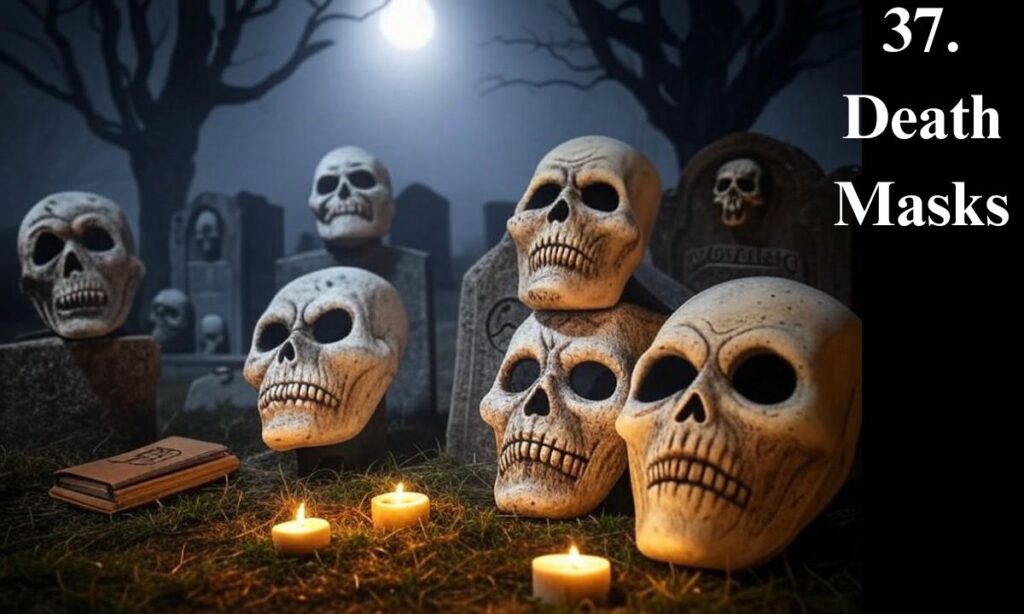
Ancient Egyptians created elaborate funeral masks. Roman aristocrats displayed ancestor masks at home. European royalty continued this tradition for centuries. These objects served both memorial and artistic purposes. Death masks demonstrate our desire to remember the individual.
38. Funeral Pyre
The funeral pyre returns bodies to elements through fire. Wood stacked carefully supports the deceased. Flames transform flesh to ash completely. Many cultures practice cremation this way. The pyre represents purification and release.
Hindu traditions favor open-air cremation. Viking funerals sometimes included boat pyres. The rising smoke symbolizes ascending spirits. This practice acknowledges physical impermanence directly. Funeral pyres demonstrate acceptance of transformation after death.
39. The Banshee
The banshee wails before impending deaths. Irish folklore features this female spirit. Her mournful cry warns families of loss. She appears as both a young and an old woman. The banshee represents foreknowledge of inevitable fate.
Celtic traditions describe her washing bloody clothes. She often attaches to specific family lines. Her predictions cannot be prevented or avoided. This spirit acknowledges grief before loss occurs. The banshee teaches that death arrives despite our resistance.
READ THIS BLOG : Are Ladybugs a Sign From Heaven?
40. Memento Mori
Memento mori translates as “remember you must die.” This philosophical concept encouraged reflection on mortality. Artists incorporated skulls into still life paintings. Jewelry sometimes featured death imagery as reminders. This phrase represents intentional awareness of finite life.
Roman generals reportedly used this phrase during triumphs. Medieval Christians kept skull objects for contemplation. Modern interpretations focus on living authentically. This reminder helps prioritize what truly matters. Memento mori encourages meaningful choices within a limited time.
Frequently Asked Questions
What are symbols of death?
Symbols of death are visual representations that cultures use to understand mortality. They include objects like skulls, animals like ravens, and figures like the Grim Reaper. These symbols help us process the complex reality of life’s end.
Why do different cultures use death symbols?
Different cultures use death symbols to make sense of mortality’s mystery. These representations help people process grief, prepare for their own deaths, and maintain connections with ancestors. They transform abstract concepts into tangible images we can understand.
What does the skull represent?
The skull represents our mortality and the equality death brings. It shows what remains after individual differences fade. Many cultures use skulls as reminders to live meaningfully before death arrives.
What does the raven symbolize in death?
Ravens symbolize the messenger aspect of death. Their black feathers, intelligence, and scavenging nature connect them with mortality. Many mythologies cast ravens as guides between worlds or as omens of approaching death.
How can symbols of death help us understand life and death better?
Death symbols help us confront mortality constructively. They provide frameworks for processing grief, preparing for our own deaths, and finding meaning in finite existence. These representations transform abstract fears into manageable concepts.
Conclusion
The 40 symbols of death reveal our complex relationship with mortality. Through ravens, hourglasses, and ancient deities, we express our understanding of life’s end. These symbols transcend cultural boundaries while maintaining unique local meanings. They help us face what cannot be avoided.
Death symbols serve as bridges between the known and unknown. They transform abstract fears into tangible images we can process. Whether through the Grim Reaper’s scythe or the phoenix’s rebirth, we find ways to express our mortality. These powerful representations comfort us in grief.

jack is an experienced blogger and a passionate wordsmith at Phrase Pioneers. With a keen eye for language and a deep love for writing, she shares insightful posts on grammar, phrases, and the art of communication.
